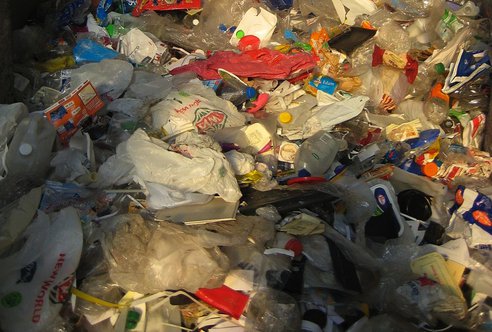Moving is so much fun, except for the part where you actually pack all your crap into boxes and move. I’m not sure you can beat its potent combination of stress, mess, and backbreaking toil outside of a prison hard-labor crew, and even those guys can find where they packed their pants at the end of the day.
And then there’s the waste. With all the cardboard boxes, Styrofoam packing peanuts, plastic bags, and transport trips involved, you can certainly add trash-producing and gas-guzzling to moving’s list of charms.
So what’s a green-minded relocator to do? I asked myself this question last week as I stared down the barrel of my impending move across town. My boyfriend, Ted, and I were headed to a nearby apartment (1.5 miles away, to be exact), and we didn’t have much time to prep — just a few weeks, and busy weeks at that. But we wanted to try for the most earth-friendly, least wasteful move possible.
While plotting the move, we identified three major offenders on the green front: packing materials, transport, and unnecessary trash. Then we set goals to attack each one. Here’s our plan — and how it all went down in reality.
Packing materials
“I hate cardboard boxes,” Ted announced early in the planning process. “Let’s just use our backpacks to haul everything.” True, we do own an unusual number of big backpacking packs (a byproduct of working in the outdoor industry), but I was still skeptical. “Everything? You mean, just toss the toaster and our dishes and everything into the packs?” That is indeed what he meant.
And it worked — for a while. We got access to the new place a few days before our official moving date, so we started early, hauling several full carloads of clothing, jackets, shoes, and books, all of it crammed into our various backpacks. We’d just show up, dump the packs’ contents on the floor, and head back for a refill. But once we’d exhausted the easily smushed items, we had to face facts: Bulky, fragile stuff would waste space in the packs, and we definitely didn’t want to make any extra trips. It was time to box.
I’ve never in my moving life bought new cardboard boxes — why, when grocery-store dumpsters are such fertile hunting grounds? But those finds tend to be on the small size, and irregularly sized to boot. I also considered renting reusable plastic boxes from a moving company like Rent a Green Box or Karmaboxx — what an idea! But you have to shell out for that kind of service. Moving boxes often lurk in the Craigslist free section, which would have been our approach if a recently relocated friend hadn’t offered up his collection. “This will be their fifth move,” he told me when I picked them up, thus inducting us into a storied tradition of moving eco-thriftiness.
And packing materials? Luckily, I’ve saved the peanuts, bubble wrap, and crumpled-up paper balls that have come in every package I’ve received over the past 18 months, sure they’d be useful someday. Today was that day. But what really saved the day was Ted’s insistence on using towels and his obscenely large T-shirt collection to cushion our wine glasses and framed photos. These materials added some bulk, yes, but we would’ve had to pack them anyway — why not make them work for it?
Transport
Unfortunate reality: Physically hauling boxes and furniture 1.5 miles (uphill!) takes energy. Short of rigging some sort of roller-pulley system and using it to yoke the sofa to a team of obliging friends, we were looking at burning gas. But how to burn the least gas?
The one car we share, a Subaru Outback, gets 20 miles to the gallon in city driving. We’d probably need a minimum of six round trips of three miles to get the boxes and other assorted odds and ends cleared out — about 0.9 gallons’ worth of gas. But wait, we’d never fit our furniture in the car, so we’d have to rent or borrow, at minimum, a pickup truck. If we managed to fit all that big stuff into two round trips at 15 mpg, plus the driving distance to and from the nearest rental joint, that’d be another 0.7 gallons for a grand total of 1.6 gallons (and maybe more).
What if we did it all in one trip — one major, UHaul trip? Though the behemoth trucks get a wince-worthy 10 mpg in the city, we’d cover the shortest distance (not to mention time) that way. So we bit the bullet, rented the smallest U-Haul we could, and drove it a grand total of 7.2 miles, or 0.72 gallons of gas. Surprise win!
Trash
I face the third significant hurdle — the creation of unnecessary trash — about three hours into any move. It’s the inevitable moment where, scratched, sweaty, and tired, I look around at my worldly possessions lying helter-skelter around the room and say, “The hell with it, let’s just toss all this s*#% out and start again.” The loveseat? Ugly. The dresser? Hate it. The photo boxes full of precious, irretrievable memories? Help me prop open the dumpster, will ya?
Ridding yourself of excess stuff without tossing it — by donating, selling, turning it into an adorable upcycled shelving unit — is a laudable goal, and one I pursue when not crazed by moving day. Doing it right takes time: You need to list items and show them to prospective buyers, or figure out how to transport stuff to Goodwill, or find a screwdriver and a hot glue gun. Not the kind of activity you have time for in a few harried weeks before a move. I should’ve cleared out the unwanted stuff well before the big day.
Yeah, well, we didn’t. But neither did I give in to my urge to throw it all away. Instead, we gritted our teeth and moved everything, even crap we bought fourth-hand from a college kid’s moving sale; we’ll find new, non-dumpster homes for it from the new place. And there’s nothing like moving to reinforce the less-is-more principle. Now more than ever, I’m going to ask of any prospective acquisition: Is this something I’d actually want to transport on another move?
In the end, we made it — sans new boxes, packing material, or trashed loveseats — and are settling into the new neighborhood for the foreseeable future. The legacy boxes are flattened and ready for move No. 6. And the extra stuff? You wouldn’t be interested in a deal on a fifth-hand lamp, now, would you?




